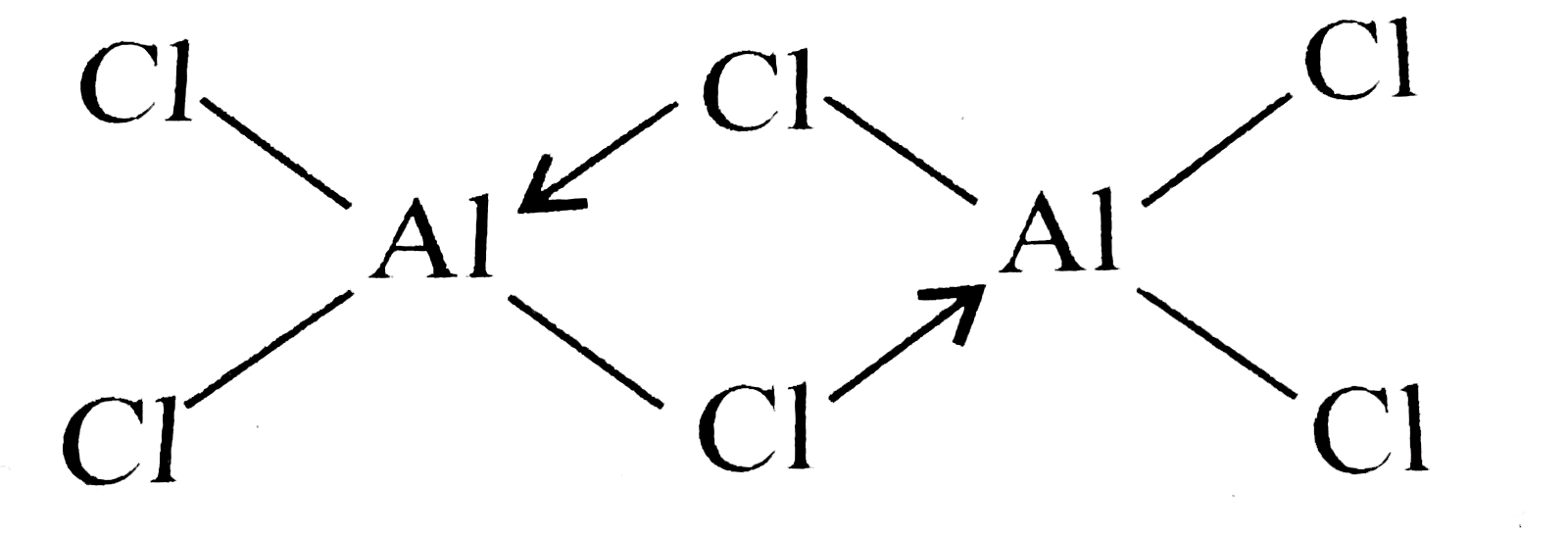An inorganic compound 'A' shows the following reactions:
(i) It is white solid, exists as dimer and fumes in wet air.
(ii) It sublimes at 180.∘C and forms monomer if heated of 400.∘C
(iii) Its aqueous solution turns litmus to red and gives a white precipitate with AgNO3 solution, which is soluble in NH4OH
(iv) Addition of NH4OH and NaOH separately to the solution of 'A' gives a gelatinous precipitate which in however soluble in excess of NaOH
The compound A is
(A) is Al2Cl6.
(a) Al2Cl6 is a white solid and exists as dimer.

Al2Cl6 fumes in moist air due to evolution of HCl gas.
Al2Cl6+6H2O→2Al(OH)3+6HCl↑⏐.
(b) Al2Cl6(s)180∘C−−−→Al2Cl6(g)400∘C−−−→2AlCl3
( c) Aqueous solution of Al∘Cl6 contains hydrated aluminium chloride, Al2Cl6, which is ionic in nature.
Al2Cl6+6H2O→Al2Cl6.6H2O or 2AlCl3.6H2O
AlCl3(aq)⇔Al3+(aq)+3ClӨ(aq)
Since the above solution is acidic, it turns blue litmus red.
AlCl3+3H2O→Al(OH)3Weak base+3HClStrong acid
On addition of AgNO3 solution in aqueous solution of aluminium chloride, white precipitate of AgCl is formed.
ClӨ(aq)+Ag⊕(aq)→AgCl↓(White ppt.)
AgCl is soluble in excess of NH4OH due to the formation of soluble complex, [Ag(NH3)2]Cl.
AgCl+2NH4OH→[Ag(NH3)2]Cl+2ӨOHDiamminesilver(I)chloride
(d) Aqueous solution of (A)+NaOH→Whitegelatinous ppt.↓Excess NaOHWhiteppt. dissolves
Al3++NaOH→Al(OH)3⏐↓White ppt.+Na⊕
Al(OH)3+NaOHExcess→NaAlO2Sodium metaluminate+2H2O
Due to the formation of Al(OH)3 initially, white gela-tionous precipitate is obtained, which dissolves on excess of NaOH due to the formation of sodium meta-aluminate.
Topper's Solved these Questions
- P-BLOCK GROUP 13 - BORON FAMILYBOOK - CENGAGE CHEMISTRY ENGLISHCHAPTER - P-BLOCK GROUP 13 - BORON FAMILYEXERCISE - Ex 6.1 (Subjective)
17 Videos
- P-BLOCK GROUP 13 - BORON FAMILYBOOK - CENGAGE CHEMISTRY ENGLISHCHAPTER - P-BLOCK GROUP 13 - BORON FAMILYEXERCISE - Ex 6.1 (Objective)
14 Videos
- P-BLOCK GROUP 13 - BORON FAMILYBOOK - CENGAGE CHEMISTRY ENGLISHCHAPTER - P-BLOCK GROUP 13 - BORON FAMILYEXERCISE - Exercise Archives (Subjecive)
9 Videos
- ORGANIC REACTION MECHANISMBOOK - CENGAGE CHEMISTRY ENGLISHCHAPTER - ORGANIC REACTION MECHANISMEXERCISE - Analytical and Descriptive
6 Videos
- P-BLOCK GROUP 14 - CARBON FAMILYBOOK - CENGAGE CHEMISTRY ENGLISHCHAPTER - P-BLOCK GROUP 14 - CARBON FAMILYEXERCISE - Exercises Archives (Subjective)
9 Videos
Similar Questions
Knowledge Check
An inorganic compound (X) shows the following reactions :
(a) It is white solid, exists as dimer and fumes in moist air.
(b) It sublimes at 180∘C and forms monomer on heating to 400∘C.
( c) Its aqueous solution turns blue litmus red and gives a white precipitate with AgNO3 solution which is soluble in excess of NH4OH.
(d) Addition of NaOH to the solution of (A) gives a white gelatinous precipitate which is, however, soluble on excess of NaOH.
Identify the compound (A).AAI(OH)3BAI2CI6CAI2O3DAI2(SO4)3NaCl(aq) gives a white precipitate with AgNO3 solution but CCl4orCHCl3 does not , because
ANaCl is a covalent compound and forms AgCl as white ppt.BNaCl is an ionic compound and forms AgCl as white ppt.CCCl4andCHCl3 are ionic compound.Dnone of these.
A colourless solid A dissolves in water. The aqueous solution gives a white precipitate B when NaOH or NH4OH is added. B dissolves in excess of NaOH but not in excess of NH4OH. BaCl2 solution added to a solution of A gives a white precipitate C which is insoluble in dilute HCI. A may be
View SolutionAn aqueous solution of colourless metal sulphate M, gives a white precipitate with NH4OH.This was soluble in excess of NH4OH. On passing H2S through this solution a white precipitate is formed.The metal M in the salt is:
View SolutionAmongst the following, the compound not soluble in excess of NH4OH solution is:
View SolutionA: The complex [Co(NH3)3Cl3] gives white ppt with AgNO3 solution
R: Chlorine always gives white ppt with AgNO3 solution
View SolutionWhich of the gives a white precipitate with a solution of AgNO3, a white precipitate with dil H2SO4 and a green flame test ?
View SolutionWhich one of the following does not give a precipitate with excess of both NaOH solution and NH3 solution ?
View Solution
